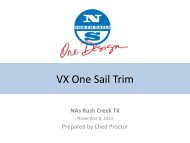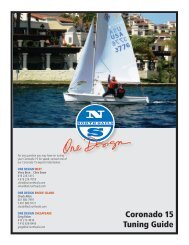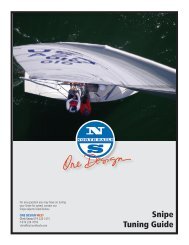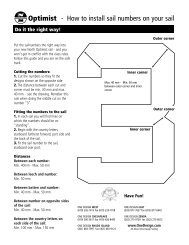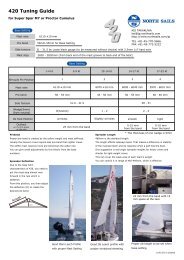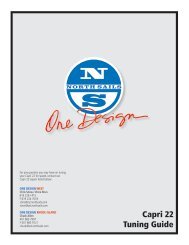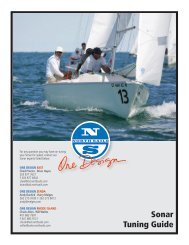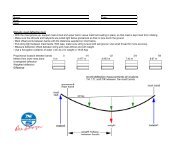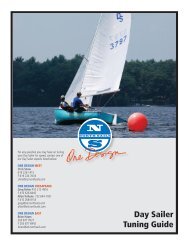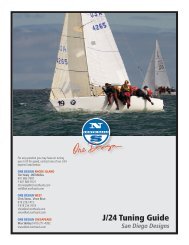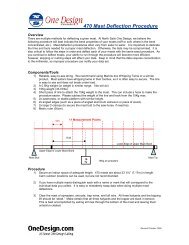Capri 14.2 Tuning Guide - North Sails - One Design
Capri 14.2 Tuning Guide - North Sails - One Design
Capri 14.2 Tuning Guide - North Sails - One Design
Create successful ePaper yourself
Turn your PDF publications into a flip-book with our unique Google optimized e-Paper software.
For any question you may have on tuningyour <strong>Capri</strong> <strong>14.2</strong> for speed, contact our<strong>Capri</strong> <strong>14.2</strong> expert listed below:ONE DESIGN WESTChris Snow619 226 1415F 619 224 7018chris@od.northsails.com<strong>Capri</strong> <strong>14.2</strong><strong>Tuning</strong> <strong>Guide</strong>
NORTH SAILS<strong>Capri</strong> <strong>14.2</strong> <strong>Tuning</strong> <strong>Guide</strong>Thanks for your purchase of <strong>North</strong> <strong>Sails</strong>for your <strong>Capri</strong> <strong>14.2</strong>. We have designedthese sails to be fast, easy to use andlong lasting. The following tuning guide ismeant to be a starting point for setting upyour rig. We have developed these settingsand instructions in order make your C <strong>14.2</strong>easy to sails and fast throughout the widerange of conditions you will encounter onthe racecourse.Setting Up the RigSince the rig on the C-<strong>14.2</strong> is prettysimple, tuning it is very easy. Our goal is toset the boat up so that the boat will havepractically “neutral helm” when sailingupwind. We need this neutral helm sothat we do not have to use the rudder toomuch upwind.Mast Rake and Shroud TensionTo achieve a neutral helm we need toset the boat up with as much rake aspermitted. The forestay length should bethe maximum allowed (15’3 3/4” per classrules). If the forestay is short either buya new one or add shackles until it is theright length.Shroud TensionThe one thing that has the most affecton the shape of your jib is the tension onthe shrouds. Because we want the sailto be flatter upwind than downwind, theshrouds are set quite loose on the C-<strong>14.2</strong>.This allows the mast to tip forward downwind and get fuller.To check your shroud tension, pull atape measure to the top of the mast andmeasure to the middle of the transomwhile your crew is holding the mastforward by pulling on the forestay. Themeasurement should be 21’ 10 1/2”to 21’11”. Adjust your shroud pins upor down as needed to achieve thesemeasurements.Sail TrimJib TrimBecause the leads on the C-<strong>14.2</strong> are set sofar outboard, it is important that the jib betrimmed quite tightly compared to otherboats when sailing upwind. In light tomedium air you will want a slight curve tothe foot. However when the breeze is upand both skipper and crew are hiking trimthe sail hard so that there is a slight creaserunning between the clew and the tack.Always sail with the jib lead all the wayforward. Your sail is cut with this in mindand having the lead forward will make thesail trim correctly.Jib halyard tension is also very importantand the halyard tension needs to beadjusted for changes in wind speed.Basically we are looking to have a slighthint of wrinkles in the luff of the sail at alltimes. As the winds picks up you will needmore halyard tension and as it decreases itwill be necessary to ease off the halyard.Downwind it pays to let off the jib halyarda bit to make the sail fuller and morepowerful.Mainsail TrimThe mainsail has a few more adjustmentsthan the jib and is actually a much moreversatile sail because of that. Follow theseguidelines for trimming the different maincontrols.BoomvangThe vang is used primarily to control theboom so that it does not rise up andrelease power from the main when thesheet is let out.Downwind tension the vang so that thetop batten is parallel to the boom.Upwind in light air the vang can be keptloose. However, when you need to starteasing the sheet, to keep the boat onits feet, it’s time to tension the vang. Inmoderate air trim the mainsheet in, to it’scorrect upwind setting, then take all theslack out of the vang. As the wind picks upmore you will need to put more tension onthe vang to de-power the lower part of sailand keep tension on the main leech as thesheet is eased.CunninghamThe cunningham controls the fore and aftposition of the draft in the main. Generallythe cunningham is kept completely looseuntil the wind reaches about 8 12 knots,from there we tension the luff of the sailso that it is just smooth.OuthaulThe outhaul is used to control the fullnessin the lower part of the sail and is kepttight upwind except in the very lightestof winds. Downwind, let the outhaul offVisit our web site at www.<strong>One</strong><strong>Design</strong>.com for the latest <strong>Capri</strong> <strong>14.2</strong> news and tuning tips.© 2007 <strong>North</strong> <strong>Sails</strong> <strong>One</strong> <strong>Design</strong>. All rights reserved.1
NORTH SAILS<strong>Capri</strong> <strong>14.2</strong> <strong>Tuning</strong> <strong>Guide</strong>about 3” to fully open up the shelf foot inthe bottom of the sail. Be careful not tolet the outhaul off too much as you canreduce the mainsail area projected to thewind.MainsheetThe mainsheet is the throttle on the boatand needs to be adjusted constantly.The best sailors rarely cleat theirmainsheet. They are continually playing itto optimize their boat’s speed.Contact <strong>North</strong> <strong>Sails</strong>For tuning information and completedetails on how to setup your <strong>Capri</strong> <strong>14.2</strong>sails contact the <strong>North</strong> <strong>Capri</strong> <strong>14.2</strong> expertslisted on the cover of this guide.Good Sailing!We start by making sure that the maintraveler is set up so that mainsheet blockstays in the middle all the time. You willneed to tie knots in the traveler to restrictthe block’s movement. Next set the heightof the apex of the traveler to 28” abovethe top of the transom. This will insure thatwhen you trim the main in all the way theblocks in the back come together.Trim the main as tight as you can to keepthe boat on its feet and sailing flat. Usethe mainsheet to control the heel of theboat and keep it tracking upwind. Becareful not to over-trim the sail as this willcause the boat to go slow and be prone totipping over quickly in a puff.We hope this guide will be a good startingpoint for you as you get to know your new<strong>North</strong> <strong>Sails</strong>. As always, please feel free togive us a call if you have any questions.Visit our web site at www.<strong>One</strong><strong>Design</strong>.com for the latest <strong>Capri</strong> <strong>14.2</strong> news and tuning tips.© 2007 <strong>North</strong> <strong>Sails</strong> <strong>One</strong> <strong>Design</strong>. All rights reserved.2
NORTH SAILS<strong>Capri</strong> <strong>14.2</strong> <strong>Tuning</strong> <strong>Guide</strong>NORTH SAILS ONE DESIGNQUALITY CONTROL CHECK<strong>Capri</strong> <strong>14.2</strong>MAINSAILCornersCunninghamNumbersBattensLeech TelltaleInsigniaTelltales<strong>North</strong> LogoBagJIBCornersLeech TelltalesLuff TabsTelltales<strong>North</strong> LogoBagChecked by: ____________________Date: ____ / ____ / ____Visit our web site at www.<strong>One</strong><strong>Design</strong>.com for the latest <strong>Capri</strong> <strong>14.2</strong> news and tuning tips.© 2007 <strong>North</strong> <strong>Sails</strong> <strong>One</strong> <strong>Design</strong>. All rights reserved.3



